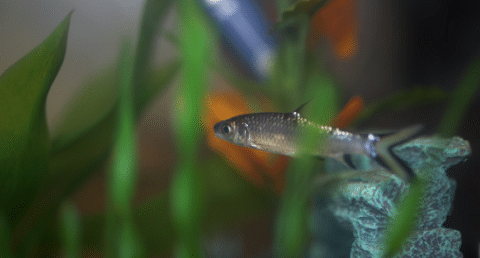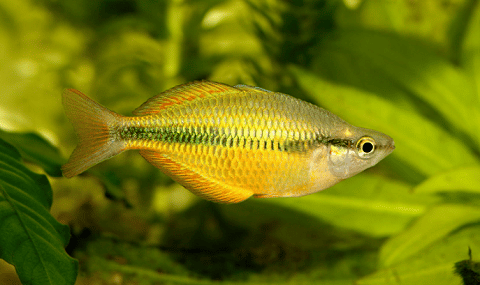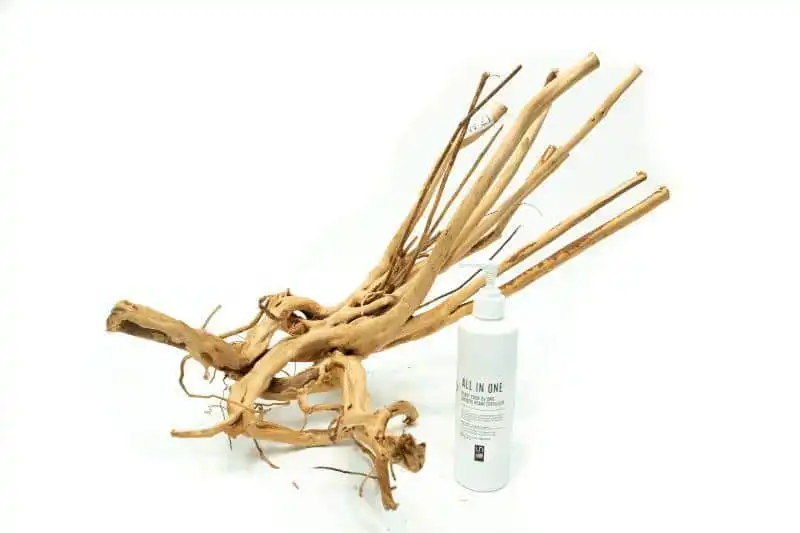Thank you for visiting! By the way… any links on this page that lead to products on Amazon and other stores/partners are affiliate links Aquarium Store Depot earns a commission if you make a purchase.
Let’s explore the fascinating world of Bala Shark care together! These beautiful freshwater fish will add some life to your aquarium, so let us guide you through everything from their origin and look to diet requirements, social behavior in captivity, breeding habits and potential health issues. With this comprehensive overview on caring for Balas Sharks under our belts, we can become true experts at it!
Key Takeaways
- Large and peaceful, Bala Sharks make a captivating addition to any large community tank!
- With proper care and nutrition, they can live up to 10 years
- They do best in a group in at least a 150 gallon tank with specific substrate & decorations.
- Choose compatible freshwater tank mates wisely for a harmonious environment + follow preventative measures for optimal health!
Species Overview
| Scientific Name | Balantiocheilos melanopterus |
| Common Names | Bala Shark, Tricolor Shark, Silver Shark, Tricolor Minnow |
| Family | Cyprinidae |
| Origin | Southeast Asia – found in rivers and lakes of Thailand, Borneo, Sumatra, and Malaysia |
| Diet | Omnivorous |
| Care Difficulty | Intermediate |
| Activity | Active |
| Life Expectancy | 10 – 15 years |
| Temperament | Generally peaceful buy may eat small fish |
| Tank Level | Mid to top level |
| Minimum Tank Size | 125 gallons |
| Temperature Range | 75-82°F (24-28°C) |
| Water Hardness | 5-15 dKH |
| pH Range | 6.5-8.0 |
| Filtration/Water Flow | Moderate to Strong |
| Water Type | Freshwater |
| Breeding | Live births |
| Difficulty to Breed | Difficult |
| Compatibility | Peaceful and social larger fish |
| OK, for Planted Tanks? | With caution |
Bala Shark Basics
Bala Sharks, also known as Tricolor Shark, Silver Shark, Bala Fish, and Balantiocheilos melanopterus, have a very distinct appearance with their silver scales along with black edged fins that make them appear similar to sharks. These freshwater fish are native to Southeast Asia, but they can be found in community tanks around the world due to their peaceful nature and active behavior making for delightful aquarium companions!
An adult Bala Shark typically reaches up to thirteen inches (over 1 foot) so it makes quite an impressive centerpiece species when kept properly. They feature a unique triangular shaped dorsal fin which adds even more of this ‘shark like‘ appeal while swimming enthusiastically throughout your tank setting.
A Peaceful shoaling and active fish by nature, these freshwater beauties peacefully interact alongside other comparable varieties within its environment -plus, you’re sure to enjoy having them around, too, since some may live up to 10 years or longer!
Origin
Bala Sharks are native to rivers and lakes of Southeast Asia, which provide ideal fast-flowing waters in their natural environment. These omnivorous creatures both consume animals and vegetation as food sources.
It is noteworthy that Bala Sharks have been labeled endangered by the IUCN1. Most today sold in aquariums come from farms so they can be purchased with a sustainable mindset for your personal community tank.
Appearance

The beauty and grace of Bala Sharks with their metallic silver bodies and pointed fins bring plenty of joy to home aquarium owners. It’s possible to identify the gender by looking at physical differences – while females are typically more curvaceous on their bellies, while males tend to be larger in size.
These aquarium fish have a very gentle demeanor which makes them adored around the world, captivating anyone who catches sight of them swimming about their environment.
Lifespan
When it comes to their lifespan, the Bala Shark can enjoy up to ten years in a healthy environment. The longevity of these fish species greatly depends on factors such as diet and tankmates. Proper water quality is key for them living out their full lifespan.
To guarantee this creature reaches its maximum potential, you must offer balanced meals and provide ideal conditions like enough room, low stress, or compatible companions. Avoid overcrowding at all costs! Stressors should be avoided if you want your Balas to make the most of every moment they have with us!
Tank Requirements
Creating the ideal environment for Bala Sharks is imperative in order to maintain their well-being and contentment. These peaceful fish can grow quite large, making it necessary that they have ample swimming space available within the tank. Replicating their natural habitat with a selection of suitable decorations and correct water parameters are key components when providing proper care for these aquatic creatures.
For successful bala shark care, regularly checking up on tank conditions is an absolute must as this will minimize common ailments amongst them while keeping them healthy at all times, including offering plenty of hiding places plus compatible companions! Nutrition plays another important factor too. By providing your fishy friends with quality feed, you can guarantee that they stay nourished in their underwater abode.
Ideal Tank Size
Since a Bala Shark gets large, they need sufficient space to grow properly. A minimum tank size of 120 gallons is suggested for them. If the fish are fully grown and supported by a group, then a large aquarium of 150-gallon and at minimum, a 5 feet wide tank should be provided. When setting up an aquarium with multiple bala sharks, remember that more room may be needed as they increase in number, so there must always be enough swimming area available for all occupants to move freely without crowding each other.
Substrate And Decorations
For Bala Sharks, a natural environment can be replicated with a dark pebbly substrate. Driftwood, large rocks and aquatic plants should also cover the water surface without blocking any view from underneath, creating an ideal living space for these creatures to thrive in!
What You See Is What You Get!
Buce offers a WSYSIWYG show pieces. Great for aquascaping. They make your aquascapes pop like no other!
Water Parameters And Filtration
In order to keep your Bala Shark healthy and happy, water conditions as well as filtration, should be kept at ideal levels. It is recommended that the temperature of their tank stay between 22–28°C (72-82°F) for optimal health. The pH level should also remain within the 6.0, 8.0 range with soft to medium hardness (5 – 12 dGH).
Keep your ammonia and nitrites at 0. Nitrates should ideally stay under 40 PPM. While they are documented cases of these fish doing fine at higher levels, you still try to adhere to general tank-keeping best practices.
Having a quality external filter plus regular 25-35% weekly water changes are both necessary for maintaining the pristine condition of your fish’s habitat so they can swim comfortably at all times.
Diet And Feeding Recommendations
Maintaining your Bala Shark’s well-being requires providing a balanced diet with all the necessary nutrients. This should include live and dried foods such as insects, crustaceans, bloodworms, brine shrimp, or anything from plant matter to diced fruits and vegetables. Such variety will keep them vigorous throughout their life.
This frozen food pack contains 4 types of formulas in one package. A great overall package for freshwater fish
It is important that you give them an assortment of nourishing foods in order for them to remain healthy and vibrant – both with regard to movement & appearance!
Feeding Schedule
Your bala shark should have a regular meal plan for you in order to keep them healthy. It’s advised that you give the fish 3 meals daily due to their high activity levels. Only give them enough food so they take around 1 minute each time eating it. Monitoring these portions correctly is fundamental since too much of it could lead to unhealthy water conditions. Providing a balanced diet along with steady feedings will help ensure the thriving existence of your Bala Shark!
Social Behavior And Ideal Tank Mates
Bala Sharks are usually peaceful and get along well with other fish types, making them a great choice for any shared aquarium. When deciding which tank mates to select for your Bala Shark, it is essential to be mindful of the best compatible species, as not all will work out harmoniously together.
These attractive peaceful fish can peacefully live in an environment with various different kinds of fish while still maintaining their community tank habitat. Nevertheless, some combinations may prove fatal if incompatible species are selected. It’s important that careful consideration when choosing fishes suitable for coexistence alongside Bala Sharks should occur before doing so.
Good Tank Mates

When selecting tank mates for Bala Sharks, it is important to choose larger non-aggressive fish that will not compete with them in terms of food or territory. Here are some good choices:
- Tinfoil barbs
- Silver Dollars
- Rainbowfish
- Giant Danios
- Plecos
- Clown Loaches
- Tiger barbs (The large size of the bala shark keeps these fish more mellow)
As long as the fish are peaceful creatures and large enough, they should make ideal companions, whereas smaller fish should be avoided as they may end up being eaten by your rapidly growing bala sharks! To ensure harmony between all the aquatic animals living together, pay close attention when deciding which species share a space. A stress-free environment can then be created thanks to carefully curated compatible tank mates for these majestic freshwater swimmers.
Bad Tank Mates
Maintaining a suitable tank environment for your Bala Shark is paramount, so it’s important to ensure compatible fish species are selected as their tank mates. Here are some bad tank mates:
- Aggressive cichlids
- Small fish like neon tetras
Semi-aggressive and competitive types of fish should not be cohabited with these sharks due to the fact that they may bully your bala shark. It would also be wise not to include small specimens such as small tetras in the same aquarium – as the bala shark have been known to consume them too! Finding appropriate bala shark companions will create an enjoyable atmosphere where both can thrive peacefully together.
Breeding: Challenges and Tips
Breeding Bala Sharks can be a difficult task due to the specific prerequisites for successful reproduction. Most of those in the aquarium trade are spawned on Asian fish farms, with few aquarists succeeding at breeding them in their tanks. This section will explore the struggles associated with growing these tropical fish and suggest some tips to anyone wanting to try it out themselves.
Sexual Maturity and Identification
Identifying the sex of Bala Sharks is important if you wish to breed them. Female Bala Sharks are more common than males in the wild. Female Bala Sharks are smaller than males and their bodies tend to be curvier, while they reach sexual maturity at around three years old with a size of five inches (13 cm). It’s possible for one to differentiate between sexes based on their shaped body and length (video source for reference).
It’s key that when attempting breeding procedures in regards to the Bala Shark, one can distinguish male from female due not only to achieving better results, but also having higher success rates altogether.
Breeding Environment
In order to breed Adult Bala Sharks, you must create an environment that replicates their native habitat in a tank of at least 55 gallons. Tank water temperature should be kept between 72-82°F with a pH level around 6.5-8 and 10, 13dGH hardness levels for the best breeding results.
Fast flowing water and plenty of vegetation is recommended as it creates a more inviting atmosphere which often helps these silver sharks spawn successfully. Although difficult, if one pays close attention to detail when setting up this specific type of aquarium, they may witness fascinating spawning behavior from Bala sharks!
Common Health Issues And Prevention
Bala Sharks, although usually quite hardy and disease-resistant, can suffer from problems such as dropsy when the tank environment is not up to par. Maintaining optimal water parameters along with a balanced diet are key factors in maintaining their health and preventing these types of issues from occurring.
To ensure that Bala Sharks remain healthy, it is important to monitor them closely for signs or symptoms of any type of illness. They should also be provided with proper care so that their habitat remains clean and safe at all times. Feeding them a nutritionally sound diet will provide essential nutrients which can help reduce potential risks associated with poor hygiene conditions in an aquarium setting.
Disease Susceptibility
Bala Sharks are usually sturdy. They can contract typical fish ailments such as Ich and Dropsy. The signs of Ich typically involve white specks on the body and fins while dropsy is a type of bacterial infection that causes bloating along with scales sticking out from their bodies.
To address these issues, one needs to change up the water in combination with antibiotics or other medications prescribed. Our blog post regarding fish diseases has several suggestions on medications to use.
Preventative Measures
To keep your Bala Sharks healthy and free from diseases, you should take several steps. Firstly, make sure to maintain high water quality in the tank they live in. Also, ensure that your Bala Shark diet is balanced and there isn’t overcrowding of fish inside the aquarium to prevent stress.
On top of this, it’s important to regularly inspect your Bala Shark for signs of common illnesses so any necessary treatment can be administered right away. Look for warning signs in your Bala Shark such as:
- Rapid breathing
- Flashing or rub on surfaces
- Staying at the top of the tank or current to aid in breathing
- Swimming upside down
- Loss of appetite
By taking these measures, you’re looking after them properly, ensuring their wellness will last!
Frequently Asked Questions
Is a bala shark aggressive?
Bala sharks have a shy and mild personality, so they’re not troublesome in any way. You should always keep them with five or more of their own kind for social and safety reasons as these non-aggressive fish do not possess the ferocity needed to stand up against semi-aggressive and aggressive aquatic life forms in the aquarium.
What you can expect is some amazing enjoyment watching these delightful animals!
How big of a tank does a bala shark need?
When it comes to tank size for a Bala Shark, the minimum capacity should be at least 125 gallons. Going bigger if you can, is even better. Because the Bala Shark enjoys swimming actively around their environment and need lots of space so they don’t become easily stressed out or frightened.
What fish can go in a tank with a bala shark?
Tiger Barbs are an ideal choice if you’re seeking to inject some excitement into your Bala shark tank. Their lively personalities, vibrancy and vivid orange-black stripes make them a terrific addition that can add life to any aquarium, plus keep the sharks on their toes!
These small but feisty fish provide perfect amusement for all who look upon it in admiration at its activities. Plus, they’ll give Bala Sharks something interesting (and perhaps even challenging) to interact with in their environment.
How many Bala sharks should I keep?
For their wellbeing and pleasure, it is wise to maintain a sizable aquarium with at least five Bala sharks. This will grant them enough room for swimming whilst also helping to shape strong connections between the fish. In turn, this should hinder any kinds of bullying or aggressive postures among each other.
Are Bala sharks hard to keep?
If you have the necessary understanding of how to maintain an appropriate living environment for your Bala Sharks, taking care of them should be a simple task. If looked after with proper attention and maintenance, they can stay in excellent health within your tank.
So why not give it a go? Give the Bala Shark what they need to prosper and watch as their health flourishes!
Closing Thoughts
When it comes to Bala Shark care, having the right tank conditions, a nutritious diet, and appropriate tank mates will help ensure that your fish thrives. The captivating appearance of these peaceful creatures makes them a delightful addition to any freshwater aquarium. If you arm your fish keeper self with this guide’s knowledge and confidence, then enjoying an adventure with bala sharks should come easy!
- About the Author
- Latest Posts
I’m thrilled that you found Aquarium Store Depot! Here you’ll find information on fish, aquariums, and all things aquatics related. I’m a hobbyist (being doing this since I was 11) and here to help other hobbyists thrive with their aquariums! I adhere to a high quality Editorial Process and Review products with real life field usage and practical analysis.







